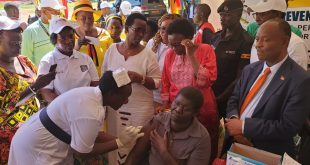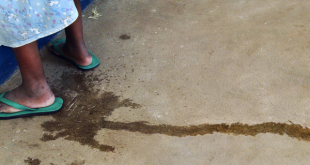Ebola Outbreak in Uganda Is Over: Here’s What Went Right
By Goodluck Musinguzi

On January 11, 2023, Uganda declared the end of the Ebola outbreak caused by the Sudan ebolavirus. The first case was reported in September 2022 and four months later the outbreak concluded with 164 confirmed and probable positive cases, 55 confirmed deaths, and 87 recovered patients. It eventually spread to nine districts in Uganda, however, no cases were reported outside the country.
While recent outbreaks of Zaire ebolavirus in Guinea and the Democratic Republic of the Congo were controlled through infection prevention and control measures, surveillance, contact tracing, and ring vaccination, there are no approved vaccines or therapeutics to prevent or treat Ebola virus disease (EVD) caused by the Sudan ebolavirus. Consequently, the potential public health impact of this outbreak in Uganda was high, and the risk of global spread was very real.
Reflecting on the response to the outbreak offers an opportunity to acknowledge what worked well and underscores the importance of preparedness.
Vaccines Were Developed at Record Speed
When a 24-year-old man in Uganda’s central Mubende district died of Ebola virus disease (EVD) in September 2022, it raised the alarm about a rare species of Ebola not seen for a decade—the last reported outbreak caused by the Sudan ebolavirus was in Uganda in 2012. Several of the young man’s relatives who died earlier in the month are also suspected to have had Ebola. While vaccinating those who have had contact with an infected individual and their contacts—known as ring vaccination—has been effective in controlling the spread of the Zaire ebolavirus, the two licensed Ebola vaccines do not offer protection against the Sudan ebolavirus.
Responding to the urgency of the outbreak, international health organizations, pharmaceutical companies, researchers, and the Ugandan health authorities coordinated to identify vaccine candidates on an unprecedented timeline.
By mid-October, the World Health Organization’s (WHO) Vaccine Prioritization Working Group had begun to evaluate the Ebola vaccine candidates for inclusion in trials. Three vaccine candidates were identified, developed by the University of Oxford/Jenner Institute UK, the Sabin Vaccine Institute USA, and the International Aids Vaccine Initiative (IAVI). And in early- and mid-December, 5,000 doses of the vaccines were sent to Uganda.
The outbreak ended before the vaccine trials could begin however the partnership between public health officials, vaccine developers, and funders sets the world up for a more rapid response in the event of a future outbreak of the Sudan ebolavirus.
On the one hand, the speed of the global response to identify candidate vaccines for inclusion in trials is example of the international collaboration needed to prevent the spread of future outbreaks of emerging special pathogens.
And on the other hand, it suggests the importance of having the infrastructure to quickly implement clinical research trials. The NETEC Special Pathogens Research Network (SPRN) has developed the Central Institutional Review Board (cIRB) to ensure that clinical trials across the Regional Emerging Special Pathogens Treatment Centers (RESPTCs) are reviewed efficiently and with the highest ethical and quality standards. The central IRB has a rapid response review process that gives researchers quicker turn-around times during special pathogens events.
If the Ebola outbreak had spread to the United States, the SPRN cIRB was prepared to serve as the IRB of record for an expanded access protocol for an investigational Monoclonal Antibody Cocktail from Mapp Biopharma for all 10 RESPTCs and the National Institutes of Health Clinical Center—the nation’s largest hospital devoted entirely to clinical research.
Experience and Expertise Guided the Response
Uganda has experience managing outbreaks of Ebola and took quick action to curb the spread of the Sudan ebolavirus. Public health authorities in Uganda worked with neighbouring countries, and Ugandan and international partners to implement readiness measures. Health care professionals, including rapid response teams and laboratorians, participated in training to refresh skills and knowledge of infection prevention and control measures; surveillance and contact tracing were activated; and public health officials engaged in community outreach about the risks and response effort.
The Uganda National Response Plan guided the activities of partners in the effort to stop the transmission of Ebola within the country and neighboring countries. The plan built on lessons learned from previous outbreaks and established best practices for response and preparedness.
In 2014, Emory University, NYC Health+Hospitals/Bellevue, and University of Nebraska Medical Center/Nebraska Medicine were selected to care for the first patients with Ebola in the United States. The staff at these facilities were trained to provide medical care for patients in high-level containment care settings, and in total 11 patients were treated.
The outbreak led to the establishment of a national network of treatment centers equipped with biocontainment units and staffed by highly trained health care professionals prepared to manage patients with Ebola or other special pathogens. Today there are 13 Regional Emerging Special Pathogens Treatment Centers (RESPTCs) that coordinate with local health departments, federal partners, and frontline facilities to prepare for and respond to special pathogen events.
The experience and expertise of the health care professionals who work at the RESPTCs support national preparedness. NETEC’s resources, education, training, research, and assessments of operational readiness draw from the vast knowledge and experience of the RESPTCs and help hospitals and EMS facilities to respond to a high consequence infectious disease like Ebola.
- The nurses, physicians, laboratorians, and emergency medical professionals at the RESPTC hospitals participate in regular training and drills with the biocontainment units.
- Subject matter experts at the RESPTCs provide input on clinical case definitions and guidance on medical countermeasures, technologies, and standard of care treatment for diagnosis and clinical management of emerging special pathogens.
- SPRN compiles and disseminates cutting edge clinical research in combating emerging pathogens.
- RESPTC subject matter experts address the unique needs and answer specific questions submitted by health care facilities and EMS agencies through virtual and onsite readiness consulting.
- RESPTCs undertake regular reviews of their preparedness.
- In-depth operational assessments coordinated by NETEC rely on subject matter experts at the RESPTCs to evaluate and respond to hospital and EMS facility requests for assessment.
- Subject matter experts at the RESPTCs develop education and training for health care workers.
- RESPTCs participate in international programming to exchange information and best practices with biocontainment units around the world.
During the outbreak of Ebola in Uganda, NETEC leveraged the unique expertise, resources, and experience of the RESPTCs to prepare health care workers who might encounter a case of Ebola. Some of the resources that were developed include:
SPRN provided support to 10 RESPTCs and the National Institutes of Health Clinical Center to onboard Sudan ebolavirus testing capabilities via the use of the Biofire and their Warrior Panel. SPRN leveraged its relationship with the NEIDL at Boston University for sharing of clinical specimens for clinical validation and ongoing performance evaluation of the diagnostic.
NETEC convened representatives from 24 biocontainment units from 10 countries, including many global partners with experience caring for patients with Ebola virus disease in 20214, to share best practices and experiences related to preparing their staff and units for potential cases of Sudan ebolavirus.
Coordination Maximized Resources and Response Capabilities
The Uganda Ministry of Health partnered with international organizations to deploy personnel, supplies, and expertise in affected areas to maximize resources and effectively respond to the outbreak.
Among other countries that donated to the response effort, the United States alone contributed more than $22.3 million to support the Ugandan government’s response to the outbreak, through the U.S. Agency for International Development (USAID), the U.S. Centers for Disease Control and Prevention (CDC), the U.S. Department of Defense (DoD), and the U.S. Department of State.
International networks rallying resources to international disease outbreak response put out requests for assistance to support case management, infection prevention and control implementation, epidemiology and surveillance, laboratory capacity, and health care worker trainings. One such network, the Global Outbreak Alert and Response Network (GOARN), received more than 60 offers from over 20 partner institutions.
In December, the WHO Regional Office for Africa, in partnership with Africa CDC, West African Health Organization, U.S. CDC, UK Health Security Agency, Robert Koch Institute, and the Bill and Melinda Gates Foundation, led a two-day public health emergency operation centre (PHEOC) simulation exercise with 36 countries in the WHO African Region, to assess and improve the functionality of countries’ public health emergency management structures.
The ministries of health of six neighboring countries—Burundi, the Democratic Republic of the Congo, Kenya, Rwanda, South Sudan, and the United Republic of Tanzania—worked with in-country and international partners to ensure readiness in their countries.
In the United States, NETEC is uniquely positioned to coordinate patient- and community-centered special pathogen care across the across public health and health care delivery systems. With support from the Department of Health and Human Services Administration for Strategic Preparedness and Response (ASPR), NETEC has developed a coordinated national strategy for responding to special pathogens called the National Special Pathogen System of Care (NSPS).
NETEC sought the input, buy-in, and commitment of diverse leaders and decision-makers across every segment of health care delivery, public health, and industry to develop the NSPS System of Care Strategy.
The NSPS System of Care will build on the existing regional special pathogen network of frontline facilities, assessment hospitals, 55 Special Pathogen Treatment Centers (SPTCs), and 13 Regional Emerging Special Pathogen Treatment Centers (RESPTCs)—expanding the number of specialized care facilities across a national Care Delivery Network. The NSPS System of Care will also establish a Coordinating Body that supports and operationalizes the Care Delivery Network and maintains connectivity with the broader NSPS in a decision-making and advisory capacity.
The NSPS System of Care will be better able to enhance special pathogen preparedness through a sustained, standardized special pathogen system of care that enables health care personnel and administrators to provide agile, patient-centered care to patients infected or suspected to be infected with a special pathogen. NSPS will improve patient outcomes, mitigate existing health care disparities, and provide all patients suspected or confirmed to be infected with a special pathogen with access to high quality care.





Great respect to the ones who made this possible
This shows how quick the Ministry is